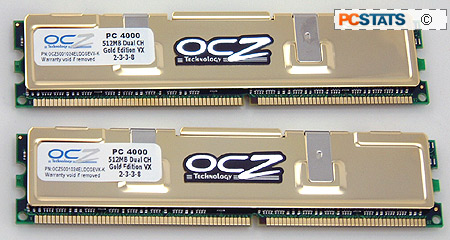For the computer geek looking
for an adventure, there has never been a better time to be an enthusiast.
Just look at all the overclocker friendly gear on the market these
days! From exotic cooling devices to flashy lights, LEDs and super-powerful power supplies, if
you have the money, it's a dream come true.
Memory has
traditionally been the weakest point in the overclocking trifecta of Processor/motherboard/memory, simply because most modules cannot run much higher
than spec. The traditional overclocker's trick with memory is to simply
raise the voltage higher and higher. While most
motherboards limit how high users can go to protect them from damaging their
components, DFI has been causing a stir in the enthusiast community by removing
these limitations.
While not
the largest memory supplier, OCZ has definitely
been a driving force when it comes to raising memory performance. Today PCStats will be testing
a set of OCZ's 512MB PC4000 Gold Dual-Channel VX (Voltage eXtreme) DDR memory. With a
name like that it had better be prepared to overclock to the roof! The PC4000 Gold Dual-Channel VX
is rated to run at 250 MHz with timings of 2-2-2-8 and a maximum voltage of
3.3V. If you do not plan to overclock this memory, the PC4000 Gold Dual Channel VX
can also run with 2-3-3-8 timings at 200 MHz with only 2.6V.
 |
|
OCZ PC4000 Gold Dual Channel VX |
|
|
 | |
Heatspreaders have become
standard equipment on memory, even if they're mostly redundant for their stated purpose. OCZ
keeps the PC4000 Gold Dual Channel VX safe with gold plated
copper heatspreaders. At PC3200 speeds the heatspreaders are only slightly warm to the
touch, but when overclocked at high voltages the heatspreaders are toasty.
I recommend that anyone planning
on using 3.3V+ with their memory should actively cool the memory modules; a 120mm
moderate CFM fan does the trick nicely.
PCSTATS Test
Methodology
PCSTATS tests DDR memory on AMD Athlon64 systems
only because Intel is still in the middle of moving its platforms over to DDR2.
Enthusiasts usually keep to the bleeding edge, so fast DDR memory is useless for
the Intel overclocker looking for more juice.
On AMD
test systems we're only interested in seeing how
high we can go with the memory running 1:1, as running with other dividers puts
the overclocking bottleneck elsewhere, not with the system memory. The DDR
RAM latency must run at 2-2-2-5, or the memory's tightest possible timings, as
quick access is more important to the CPU design. Just for arguments sake, we
will also be conducting overclocking tests to see how high the memory will go
with conservative timings (3-3-3-9) although we will only benchmark the system with
the tight memory timings mentioned above. Let's get started!

